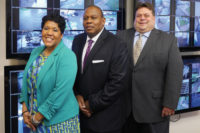The security industry’s calendar seems to revolve around a few key events: ISC West, ASIS International’s Global Security Exchange (GSX), ISC East… But have you ever considered how much effort goes into securing tradeshows and other large-scale events? Security discussed how convention security differs from sporting event security, among other events, and what CSOs should know before moving forward with an event with Brad Mayne, President and Chief Executive Office of the International Association of Venue Managers (IAVM), an association representing public assembly venues around the world, including auditoriums, arenas, convention centers, exhibit halls, stadiums, performing arts studios, university complexes and amphitheaters.
SECURITY: What are some of the main risks and challenges of securing a convention or association event?
Mayne: The main overall challenge of securing a convention or association event is the current threat environment of homegrown extremists throughout the world who are focused on anywhere the public gathers, coupled with the fact that public venues have been designed for public accessibility for the communities they serve. Another challenge with convention centers in particular is they host multiple events at the same time. Convention venues have large spaces, freight doors for access to event rooms, multiple public doors, public walkways through the venue and other unique physical layouts that demand a high level of attention.
SECURITY: What makes securing a convention or conference different from securing other large-scale events, such as sporting events or concerts?
Mayne: Convention and conference centers require open access by nature, while sports and entertainment venues have been designed to need a form of ticket or pass to enter the venue. This pre-entry process secures sports and concert venues at key locations outside the building, or at minimum, at the building’s entryways.
SECURITY: What proactive steps should security leaders for convention spaces take for each event, and how early should they start, in general?
Mayne: The first step in securing a building and the events it hosts is to implement a third-party risk assessment for the venue as well as for each specific event. The building risk assessment should be completed as part of the commissioning of the venue. The assessment for the event should be determined prior to the event with enough time to implement the plan during the move-in portion of the schedule. Based on the risk assessment, the venue manager and event manager need to collectively determine a security plan and implementation that is reasonable for the event.
Another part of the security plan needs to be the ability to react in times of trouble or tragedy. No matter how strong a venue’s security plan and implementation may be, there will still be a possibility of challenges or tragedy. This uncertainty requires the venue, show and local authorities be committed to responding to challenging situations just as much as they are committed to stopping the attempts from happening.
SECURITY: How does security technology play a role in mitigating convention security risks?
Mayne: Technology is ever-changing and making a great and positive difference in securing venues and events. Every venue employs different technologies based on their resources and specific needs in their community, but these intelligent electronics can be very effective and an integral part of the event security plan. Show organizers also have technologies available to them, and both the venue and the show must coordinate the technologies to be used for each event, so there is a clear plan on their use.
SECURITY: How can security leaders ensure that security personnel throughout a space are prepared for each new event? (i.e., training, awareness, drills and tabletops)
Mayne: Security leadership needs to ensure security personnel are vetted, trained and given resources to accomplish their responsibilities. It is essential security staff are knowledgeable of the venue’s security plans and resources, which need to include smart practices and protocols that are practical, scalable and efficient in mitigating risk. Tabletop exercises, in which challenging scenarios are discussed, are a great tool for staff to determine emergency plans and options for implementation. Individuals involved in these exercises become more aware of potential threats and how to address them quickly and correctly.
SECURITY: Do you have any overall best practices for convention security that you think CSOs should know about?
Mayne: The most important change on the horizon that CSOs should be aware of is the industry’s Exhibition Meetings Safety and Security Initiative (EMSSI), which is dedicated to creating smart practices and protocols for the meetings and exhibition industry. This effort is being led by IAVM, IAEE and ESCA in conjunction with the Department of Homeland Security’s Safety Act Office. The mutual relationship with DHS and the organization’s resources is a real plus for CSOs, because venues will use the industry document as a tool to apply for and achieve Safety Act Designation and eventually Certification.
More than 60 organizations are in support of EMSSI thus far, and that number is expected to grow. The Industry Security Council is completing the final review of the industry document, and it is anticipated to be available to convention centers through a secure portal in the later part of this year.
In addition to supporting EMSSI, continuous staff education and training is key. IAVM has several training programs, such as the Academy for Venue Safety and Security, that venues have been taking advantage of over the past year. Our curriculum was designed by experts in the field and equips venue professionals and staff with best practices, resources, and tools, so they are better prepared to face the evolving challenge of providing a safe venue for everyone.
SECURITY: Where can security leaders go to learn more about this topic?
Mayne: As we move forward with this initiative, go to www.IAVM.org/EMSSI, which will provide updates on the EMSSI program. The U.S. Department of Homeland Security is another strong resource, given its mandate to offer resources to protect public infrastructure.






